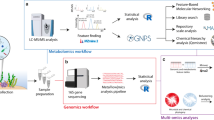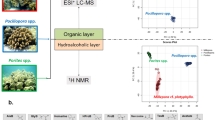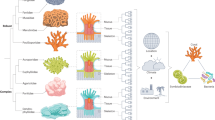Abstract
Coral bleaching has a profound impact on the health and function of reef ecosystems, but the metabolomic effects of coral bleaching are largely uncharacterized. Here, untargeted metabolomics was used to analyse pairs of adjacent Montipora capitata corals that had contrasting bleaching phenotypes during a severe bleaching event in 2015. When these same corals were sampled four years later while visually healthy, there was a strong metabolomic signature of bleaching history. This was primarily driven by betaine lipids from the symbiont, where corals that did not bleach were enriched in saturated lyso-betaine lipids. Immune modulator molecules were also altered by bleaching history in both the coral host and the algal symbiont, suggesting a shared role in partner choice and bleaching response. Metabolomics from a separate set of validation corals was able to predict the bleaching phenotype with 100% accuracy. Experimental temperature stress induced phenotype-specific responses, which magnified differences between historical bleaching phenotypes. These findings indicate that natural bleaching susceptibility is manifested in the biochemistry of both the coral animal and its algal symbiont. This metabolome difference is stable through time and results in different physiological responses to temperature stress. This work provides insight into the biochemical mechanisms of coral bleaching and presents a valuable new tool for resilience-based reef restoration.
This is a preview of subscription content, access via your institution
Access options
Access Nature and 54 other Nature Portfolio journals
Get Nature+, our best-value online-access subscription
$29.99 / 30 days
cancel any time
Subscribe to this journal
Receive 12 digital issues and online access to articles
$119.00 per year
only $9.92 per issue
Buy this article
- Purchase on Springer Link
- Instant access to full article PDF
Prices may be subject to local taxes which are calculated during checkout





Similar content being viewed by others
Data availability
Feature-based molecular networking is available at: https://gnps.ucsd.edu/ProteoSAFe/status.jsp?task=bb9b6126118c4ba1881f4483560012d3 and raw files are available at massive.ucsd.edu under MassIVE IDs MSV000085272 and MSV000085925. Ecological and metabolomic data and analysis scripts are available at https://github.com/druryc/mcap_metabolomics.
References
LaJeunesse, T. C. et al. Systematic revision of Symbiodiniaceae highlights the antiquity and diversity of coral endosymbionts. Curr. Biol. 28, 2570–2580 (2018).
Muscatine, L. & Porter, J. W. Reef corals: mutualistic symbioses adapted to nutrient-poor environments. BioScience 27, 454–460 (1977).
van Hooidonk, R., Maynard, J. A. & Planes, S. Temporary refugia for coral reefs in a warming world. Nat. Clim. Change 3, 508–511 (2013).
National Academies of Sciences, Engineering, and Medicine A Research Review of Interventions to Increase the Persistence and Resilience of Coral Reefs (The National Academies Press, 2019); https://doi.org/10.17226/25279
Barshis, D. J. et al. Genomic basis for coral resilience to climate change. Proc. Natl Acad. Sci. USA 110, 1387–1392 (2013).
Palumbi, S. R., Barshis, D. J., Traylor-Knowles, N. & Bay, R. A. Mechanisms of reef coral resistance to future climate change. Science 344, 895–898 (2014).
Bay, R. & Palumbi, S. Rapid acclimation ability mediated by transcriptome changes in reef-building corals. Genome Biol. Evol. 7, 1602–1612 (2015).
Grottoli, A. G. et al. Coral physiology and microbiome dynamics under combined warming and ocean acidification. PLoS ONE 13, e0191156 (2018).
Ziegler, M., Seneca, F., Yum, L. & P, S.-N. Bacterial community dynamics are linked to patterns of coral heat tolerance. Nat. Commun. 8, 14213 (2017).
Hillyer, K. E. et al. 13C metabolomics reveals widespread change in carbon fate during coral bleaching. Metabolomics 14, 12 (2018).
Hillyer, K. E. et al. Metabolite profiling of symbiont and host during thermal stress and bleaching in the coral Acropora aspera. Coral Reefs 36, 105–118 (2017).
Sogin, E. M., Putnam, H., Gates, R. D., Putnam, H. M. & Anderson, P. E. Metabolomic signatures of increases in temperature and ocean acidification from the reef-building coral Pocillopora damicornis. Metablomics 12, 71 (2016).
Hillyer, K. E., Tumanov, S., Villas-Bô As, S. & Davy, S. K. Metabolite profiling of symbiont and host during thermal stress and bleaching in a model cnidarian-dinoflagellate symbiosis. J. Exp. Biol. https://doi.org/10.1242/jeb.128660 (2016).
Fisch, J., Drury, C., Towle, E. K., Winter, R. N. & Miller, M. W. Physiological and reproductive repercussions of consecutive summer bleaching events of the threatened Caribbean coral Orbicella faveolata. Coral Reefs 38, 863–876 (2019).
Pinzón, J. H. et al. Whole transcriptome analysis reveals changes in expression of immune-related genes during and after bleaching in a reef-building coral. R. Soc. Open Sci. 2, 140214 (2015).
Thomas, L. & Palumbi, S. R. The genomics of recovery from coral bleaching. Proc. R. Soc. B 284, 20171790 (2017).
Wall, C. B. et al. Shifting baselines: repeat bleaching drives coral physiotypes through environmental legacy and cellular memory. Preprint at bioRxiv https://doi.org/10.1101/2020.04.23.056457 (2020).
Matsuda, S. et al. Coral bleaching susceptibility is predictive of subsequent mortality within but not between coral species. Front. Ecol. Evol. 8, 178 (2020).
Howells, E. J., Abrego, D., Meyer, E., Kirk, N. L. & Burt, J. A. Host adaptation and unexpected symbiont partners enable reef-building corals to tolerate extreme temperatures. Glob. Change Biol. 22, 2702–2714 (2016).
van Oppen, M. J. H. et al. Shifting paradigms in restoration of the world’s coral reefs. Glob. Change Biol. 23, 3437–3448 (2017).
Anthony, K. R. N. et al. Operationalizing resilience for adaptive coral reef management under global environmental change. Glob. Change Biol. 21, 48–61 (2015).
da Silva, R. R., Lopes, N. P. & Silva, D. B. in Mass Spectrometry in Chemical Biology: Evolving Applications (eds da Silva, R. R. & Lopes, N. P.) 57–81 (Royal Society of Chemistry, 2017).
Cunning, R., Ritson-Williams, R. & Gates, R. Patterns of bleaching and recovery of Montipora capitata in Kāne’ohe Bay, Hawai’i, USA. Mar. Ecol. Prog. Ser. 551, 131–139 (2016).
Sumner, L. W. et al. Proposed minimum reporting standards for chemical analysis: Chemical Analysis Working Group (CAWG) Metabolomics Standards Initiative (MSI). Metabolomics 3, 211–221 (2007).
Rosset, S. et al. Lipidome analysis of Symbiodiniaceae reveals possible mechanisms of heat stress tolerance in reef coral symbionts. Coral Reefs 38, 1241–1253 (2019).
Li, Y. et al. Simultaneous structural identification of diacylglyceryl-N-trimethylhomoserine (DGTS) and diacylglycerylhydroxymethyl-N,N,N-trimethyl-β-alanine (DGTA) in microalgae using dual Li+/H+ adduct ion mode by ultra-performance liquid chromatography/quadrupole time‐of‐flight mass spectrometry. Rapid Commun. Mass Spectrom. 31, 457–468 (2017).
Matthews, J. L. et al. Optimal nutrient exchange and immune responses operate in partner specificity in the cnidarian–dinoflagellate symbiosis. Proc. Natl Acad. Sci. USA 114, 13194–13199 (2017).
Weis, V. M. Cellular mechanisms of cnidarian bleaching: stress causes the collapse of symbiosis. J. Exp. Biol. 211, 3059–3066 (2008).
Mansour, J. S., Pollock, F. J., Díaz-Almeyda, E., Iglesias-Prieto, R. & Medina, M. Intra- and interspecific variation and phenotypic plasticity in thylakoid membrane properties across two Symbiodinium clades. Coral Reefs 37, 841–850 (2018).
Roach, T. N. F. et al. A multiomic analysis of in situ coral–turf algal interactions. Proc. Natl Acad. Sci. USA 117, 13588–13595 (2020).
Quinn, R. A. et al. Metabolomics of reef benthic interactions reveals a bioactive lipid involved in coral defence. Proc. R. Soc. B 283, 20160469 (2016).
Rosset, S., Wiedenmann, J., Reed, A. J. & D’Angelo, C. Phosphate deficiency promotes coral bleaching and is reflected by the ultrastructure of symbiotic dinoflagellates. Mar. Pollut. Bull. 118, 180–187 (2017).
Galtier d’Auriac, I. et al. Before platelets: the production of platelet-activating factor during growth and stress in a basal marine organism. Proc. R. Soc. B 285, 20181307 (2018).
Quistad, S. D. et al. Evolution of TNF-induced apoptosis reveals 550 My of functional conservation. Proc. Natl Acad. Sci. USA 111, 9567–9572 (2014).
Williams, A. et al. Metabolomic shifts associated with heat stress in coral holobionts. Sci. Adv. 7, eabd4210 (2021).
Takahashi, N. Chemistry of Plant Hormones (CRC, 1986).
Reyes, F., Martín, R. & Fernández, R. Granulatamides A and B, cytotoxic tryptamine derivatives from the soft coral Eunicella granulata. J. Nat. Prod. 69, 668–670 (2006).
Hill, R., Larkum, A. W. & Kramer, D. Light-induced dissociation of antenna complexes in the symbionts of scleractinian corals correlates with sensitivity to coral bleaching. Coral Reefs 31, 963–975 (2012).
Venn, A. A., Wilson, M. A., Trapido-Rosenthal, H. G., Keely, B. J. & Douglas, A. E. The impact of coral bleaching on the pigment profile of the symbiotic alga, Symbiodinium. Plant Cell Environ. 29, 2133–2142 (2006).
Martin, F. J. et al. A top-down systems biology view of microbiome–mammalian metabolic interactions in a mouse model. Mol. Syst. Biol. 3, 112 (2007).
Quinn, R. A. et al. Global chemical effects of the microbiome include new bile-acid conjugations. Nature 579, 123–129 (2020).
Wikoff, W. R. et al. Metabolomics analysis reveals large effects of gut microflora on mammalian blood metabolites. Proc. Natl Acad. Sci. USA 106, 3698–3703 (2009).
Dixon, G., Abbott, E. & Matz, M. Meta-analysis of the coral environmental stress response: Acropora corals show opposing responses depending on stress intensity. Mol. Ecol. https://doi.org/10.1111/mec.15535 (2020).
Boström-Einarsson, L. et al. Coral restoration – a systematic review of current methods, successes, failures and future directions. PLoS ONE 15, e0226631 (2020).
Van Oppen, M. J. H., Oliver, J. K., Putnam, H. M. & Gates, R. D. Building coral reef resilience through assisted evolution. Proc. Natl Acad. Sci. USA 112, 2307–2313 (2015).
Baums, I. B. et al. Considerations for maximizing the adaptive potential of restored coral populations in the western Atlantic. Ecol. Appl. 29, e01978 (2019).
Bay, R., Rose, N., Logan, C. & Palumbi, S. Genomic models predict successful coral adaptation if future ocean warming rates are reduced. Sci. Adv. 3, e1701413 (2017).
Dührkop, K. et al. SIRIUS 4: a rapid tool for turning tandem mass spectra into metabolite structure information. Nat. Methods 16, 299–302 (2019).
Pluskal, T., Castillo, S., Villar-Briones, A. & Orešič, M. MZmine 2: modular framework for processing, visualizing, and analyzing mass spectrometry-based molecular profile data. BMC Bioinform. 11, 395 (2010).
Wang, M. et al. Sharing and community curation of mass spectrometry data with Global Natural Products Social Molecular Networking. Nat. Biotechnol. 34, 828–837 (2016).
Nothias, L.-F. et al. Feature-based molecular networking in the GNPS analysis environment. Nat. Methods 17, 905–908 (2020).
Martin, C. et al. Viscosin-like lipopeptides from frog skin bacteria inhibit Aspergillus fumigatus and Batrachochytrium dendrobatidis detected by imaging mass spectrometry. Sci. Rep. 9, 3019 (2019).
Cunning, R., Gillette, P., Capo, T., Galvez, K. & Baker, A. C. Growth tradeoffs associated with thermotolerant symbionts in the coral Pocillopora damicornis are lost in warmer oceans. Coral Reefs 34, 155–160 (2015).
Cunning, R. & Baker, A. C. Excess algal symbionts increase the susceptibility of reef corals to bleaching. Nat. Clim. Change 3, 259–262 (2013).
Acknowledgements
We thank R. Gates for the inspiration to use molecular tools to investigate corals and develop real-world solutions to the global coral reef crisis. This work was funded by the Paul G. Allen Family Foundation. Lastly, we thank C. Cornell and K. Neugebauer for close reading and critique of the manuscript throughout the writing process. This is SOEST contribution number 11209 and HIMB contribution number 1838.
Author information
Authors and Affiliations
Contributions
T.N.F.R. and C.D. conceived the experiment. T.N.F.R., J.D., R.A.Q. and C.D. collected data. All authors analysed data, wrote the manuscript and approved the final version.
Corresponding authors
Ethics declarations
Competing interests
The authors declare no competing interests.
Additional information
Peer review information Nature Ecology & Evolution thanks Olivier Thomas, Simon Davy and the other, anonymous, reviewer(s) for their contribution to the peer review of this work. Peer reviewer reports are available.
Publisher’s note Springer Nature remains neutral with regard to jurisdictional claims in published maps and institutional affiliations.
Extended data
Extended Data Fig. 1 Kāneʻohe and coral bleaching history.
Corals were collected from Reef 13 in Kāneʻohe Bay, Oʻahu, Hawaiʻi (a). A representative pair of bleached and non-bleached corals at Reef 13 during the 2015 bleaching event (b). Overall sampling schematic (c). Abbreviations in panel C are as follows: NB=Non-Bleached and B=Bleached.
Extended Data Fig. 2 Metabolome diversity metrics.
Diversity metric for the metabolomes of bleached (B) and non-bleached (NB) corals including Shannon’s entropy (a), richness (b), and evenness (c). Boxplots are median with quartiles and whiskers extending 1.5 IQR beyond quartiles.
Extended Data Fig. 3 DGCC lipid MS/MS.
Extracted ion chromatogram and MS/MS spectra of betaine lipid DGCC 16:0/0:0 described in this manuscript in positive (a) and negative (b) modes. The proposed annotation of each selected fragment ion is highlighted by a red number.
Extended Data Fig. 4 DGCC lipid abundances and saturation index.
Box and whisker plots of (a) the most abundant fully saturated betaine lipid for the in situ validation corals and (b) the most important molecule for distinguishing between phenotypes from the random forests variable importance plot. Boxplots are median with quartiles and whiskers extending 1.5 IQR beyond quartiles. c, DGCC unsaturation index (calculated according to Rosette et al. 2019) from experimental bleached and non-bleached corals. d, Log total abundance of lyso-DGCC lipids from experimental corals. Boxplots are median with quartiles and whiskers extending 1.5 IQR beyond quartiles.
Extended Data Fig. 5 DGTS lipid abundances.
DGTS lipid abundances in corals based on HBP. These betaine lipids do not exhibit substantial differences between HBPs like the related DGCCs. Boxplots are median with quartiles and whiskers extending 1.5 IQR beyond quartiles. auc= area under curve.
Extended Data Fig. 6 Symbiont genotypes in corals from this study.
Relative symbiont abundance of genotypes in the study in 2019 (a) and for a larger set that includes validation samples from 2018 (b). Cladocopium vs Durursdinium dominance is stable over time.
Extended Data Fig. 7 Betaine lipids and algae abundances.
Linear regression of saturated (A,C) and unsaturated (B,D) betaine lipids versus Cladocopium (A,B) and Durisdinium (C,D) algal symbionts. Shaded areas represent 95% confidence intervals.
Extended Data Fig. 8 Known metabolite relationships with bleaching history.
a, PCA of lab corals using only known compounds. Points (n = 5 per genotype) represent individual samples colored by genotype (n = 10). Fill represents HBP (gray = non-bleached, white = bleached). b, PCA of field validation set using only known compounds. Points represent single samples from individual genotypes in the validation set which were not evaluated in panel A (n = 12). Fill represents HBP (gray = non-bleached, white = bleached). c, All known compounds ranked by descending variable importance for discriminating between HBPs. Colors represent molecular families assigned to individual molecules corresponding to Fig. 1. d, Relative variable importance of molecular families in all known compounds, arranged by ascending median rank (lower is more informative). Individual points correspond to ranked molecules in panel C, with horizontal bars showing first and third quartiles of each molecular family. Colors represent molecular families as in panel C.
Extended Data Fig. 9 Abundances of known compounds in bleached and non-bleached corals.
Box and whisker plots of biologically interesting known metabolites in the ‘lab corals’ (a-e) and the in situ ‘validation corals’ (f-j). Coral host-derived metabolites pantothenic acid (k) and tryptamine (l). Boxplots are median with quartiles and whiskers extending 1.5 IQR beyond quartiles. y-axis is the area under curve abundance.
Extended Data Fig. 10 Symbiont and bleached metabolome relationships with bleaching history and molecular family responses to heat stress.
PCA of all metabolites found in replicate symbiont pellets (a) and all metabolites found in replicate bleached host fragments (b). These samples were collected from colony 19 and 20, which are included in the larger lab dataset and represent a bleached and non-bleached colony, respectively. Fill represents HBP (gray = non-bleached, white = bleached). Multivariate response to heat stress for (c) Membrane Lipids and (d) Bioactive Molecules (e) Putative Microbial Products. Fill represents HBP (gray = non-bleached, white = bleached). Color represents initial and heat stress timepoints (black = initial, red = heat stress). Gray ellipses represent 95% confidence interval of phenotypes. Gray bars connect paired before-after samples.
Supplementary information
Supplementary Information
Supplementary Figs. 1–6 and Tables 1–5.
Rights and permissions
About this article
Cite this article
Roach, T.N.F., Dilworth, J., H., C.M. et al. Metabolomic signatures of coral bleaching history. Nat Ecol Evol 5, 495–503 (2021). https://doi.org/10.1038/s41559-020-01388-7
Received:
Accepted:
Published:
Issue Date:
DOI: https://doi.org/10.1038/s41559-020-01388-7
This article is cited by
-
Coral thermal stress and bleaching enrich and restructure reef microbial communities via altered organic matter exudation
Communications Biology (2024)
-
Complex parental effects impact variation in larval thermal tolerance in a vertically transmitting coral
Heredity (2024)
-
Assessing Molecular Localization of Symbiont Microalgae in Coral Branches Through Mass Spectrometry Imaging
Marine Biotechnology (2024)
-
No apparent trade-offs associated with heat tolerance in a reef-building coral
Communications Biology (2023)
-
Spatial extent of dysbiosis in the branching coral Pocillopora damicornis during an acute disease outbreak
Scientific Reports (2023)



